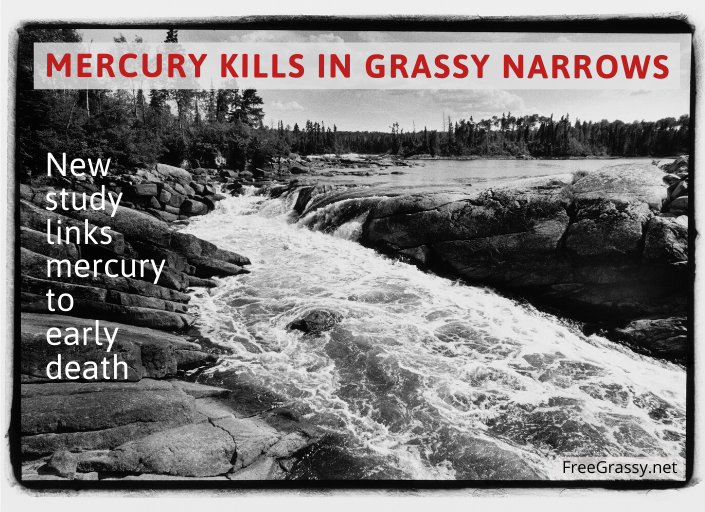Early death linked to mercury in Grassy Narrows

Grassy Narrows people with higher long-term mercury exposure were far more likely to die early according to an authoritative new study published Monday evening in the Lancet Planetary Health scientific journal.
The study is the first to directly support Grassy Narrows’ long held belief that their people are dying young because of the ongoing impact of mercury poisoning which started in 1962 when an upstream paper mill began dumping 10 tonnes of mercury into Grassy Narrows’ English-Wabigoon River system. Only 14% of Grassy Narrows people currently get compensation from the Mercury Disability Board.
“Every single person in Grassy Narrows has been hurt by mercury whether it is loss of loved ones, sickness, poverty, or loss of culture,” said Chief Rudy Turtle of Grassy Narrows. “The government must do what is right and fully compensate everyone in Grassy Narrows for our profound loss so that we can restore our thriving community that we had before mercury.”
While people in Canada are grappling with the increased risk of death for people over 70 due to COVID-19, people in Grassy Narrows have faced an ongoing multi-decadal crisis which has led to a much higher risk of dying before 60.
The study analyzed thousands of mercury blood and hair measurements, collected from 657 people in Grassy Narrows between 1970 and 1997 by the governments of Ontario and Canada, along with information on who had died and when. The study focused on mercury exposure of persons who were born before 1959 and thus reached or could have reached 60 years of age by 2019.
The data in this study has long been available to the government but was never properly analyzed to test for evidence of early death. Instead, the government insisted for decades that while people had been exposed to mercury in Grassy Narrows, and the community has suffered from social disruption, there was no evidence that mercury had harmed their health.
A Government of Canada briefing note from 2017 obtained through a Freedom of Information request stated that “According to Health Canada, and their review of the health and mercury related data accumulated over the past 45 years, there is no data to confirm whether there is a greater rate of disability or significant health problems, in comparison to other First Nations, in either Grassy Narrows or [another nearby First Nation] at this time.”
Between 1970 and 1992, 71,842 samples from 38,571 persons from 514 First Nation communities, were analysed by Health Canada. The highest concentration of blood mercury was 660 µg/L from a person in Grassy Narrows. (Wheatley and Paradis, 1995)
Grassy Narrows was a thriving and self-sufficient community with a rich culture and 95% employment, mostly in the commercial and sport fisheries. Fifty years after the mercury pollution forced the community into an ongoing crisis, Grassy Narrows’ resilient people continue to fight for justice and to restore their self-determination, culture, and environment.
Key findings from the study:
- Different methodological approaches all confirm that premature death was associated with long term mercury exposure in Grassy Narrows,
- People who died before 60 in Grassy Narrows had almost five times higher long-term mercury exposure than those who lived beyond 60 years of age,
- People with at least one hair mercury measure greater than 15 µg/g had a 55% higher risk of dying at a younger age,
- 42% of persons born before 1959 had at least one mercury hair concentrations above 15 µg/g,
- Longevity decreased by one year with every 6.25 µg/g increase in hair mercury.
The study was authored by Drs. A. Philibert, M. Fillion and D. Mergler from the Centre for Interdisciplinary Research on Well-being, Health, Society and the Environment (CINBIOSE) of the Université du Québec à Montréal and Université TELUQ. The research team was led by Dr. Donna Mergler, an internationally recognized expert on the health effects of mercury for more than 25 years.
The full text of the published study can be found at: https://www.thelancet.com/pdfs/journals/lanplh/PIIS2542-5196(20)30057-7.pdf
News Stories:
- Toronto Star
- Radio-Canada (French, first)
- Radio-Canada (French, second)
- APTN
- Kenora Online




